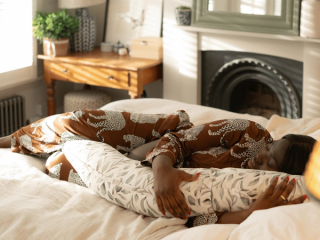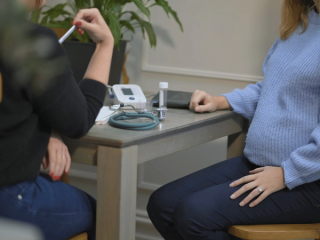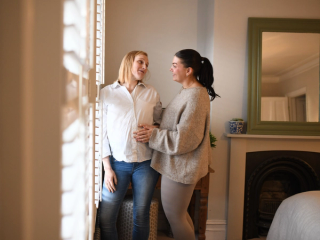
- Home
- Advice And Support
- Pregnancy
- Pregnancy Care
- Prenatal Massages
Prenatal Massages: What is it and What are the Benefits?
Learn about prenatal massages and benefits for expectant mothers, including stress relief, improved circulation, and better sleep.
What are prenatal massages?
What are the benefits of prenatal massage?
Are prenatal massages safe?
When is the best time to get a prenatal massage?
Can a prenatal massage induce labour?
How is prenatal massage done?
How to find the right pregnancy massage therapist for you
Prenatal massage at home
After a massage
Let’s face it: pregnancy is hard on the body, and on the mind. Besides the aches and pains that come with lugging around a growing baby, placenta, and all that fluid, your mind is also working overtime, perhaps planning for the baby’s arrival, feeling anxious about labour and delivery, or just worrying about all the things you need to get done before you go on maternity leave.
Pregnancy massage can help to relieve tension in your muscles, alleviate joint pain, and relax your mind. Spending time totally focused on you is an act of mindfulness in itself, helping you get out of your head and connect with your body. You can go to see a specialist massage therapist or put your partner to work and enjoy some time together.
What are prenatal massages?
Like any massage, pregnancy massage, sometimes called prenatal massage, is a technique wherein your partner or massage therapist uses their hands on your skin to relieve the tension you are carrying in your body. Techniques range from gentle stroking to rubbing in lines or circles, and even squeezing. While regular massages are often done with a lot of deep pressure, pregnancy massages are much gentler.
You can have full body massages, back massages, foot massages, head and scalp massages – the full range of treatments. Unlike a normal massage, the position you take will usually depend on how far along you are in your pregnancy. As your bump grows you will need to adopt a side-lying or seated position or find a massage therapist who has a special massage table designed to accommodate your bump.
What are the benefits of prenatal massage?
A peaceful pregnancy massage can have benefits at any time through your pregnancy and even during labour, when massage can help reduce the pain of contractions.
The main reasons people seek out a pregnancy massage are for pain relief and relaxation. Back pain, hip pain, neck and shoulder pain can all be alleviated with some gentle massage. Tuning into your body’s needs can also help relieve anxiety, giving you the time you need to relax and rest your mind.
As an additional benefit, prenatal massage can help you sleep better – particularly if you enlist your partner to give you a gentle massage before bed. What’s more, pregnancy massage also improves circulation, which can help reduce swelling – something that can become more of a problem as your pregnancy progresses.
Are prenatal massages safe?
As we all know, the risk of miscarriage is highest in the first trimester. Perhaps for this reason, the general advice is to wait until the second trimester to seek out a pregnancy massage – though there is no evidence to link miscarriage and massage. At any time during your pregnancy, it is best to talk to your healthcare professional before booking a massage, as they will know if you have any conditions that mean it’s not a good idea.
When you do come to book a massage, look for a therapist who has the specific prenatal massage certifications that qualify them to undertake pregnancy massages. If you are meeting the therapist for the first time, they should always take the time to talk to you first, to understand why you’ve come, what you’re happy with them doing, and what you don’t feel comfortable with.
When is the best time to get a prenatal massage?
As mentioned, it’s best to wait for your second trimester before getting a prenatal massage. However, there is no wrong time in the second or third trimester – get one whenever you need/want/can afford one and just enjoy the opportunity to relax. Whether you’re suffering with aches and pains or not, a massage will relax tense muscles and help give you some of that special ‘me time’ you deserve. If you can only afford to do it once, it’s worth waiting until the mid-to-end of your third trimester when you’re likely to feel the benefits the most.
Can a prenatal massage induce labour?
There’s no evidence to suggest that massage can induce labour, though massage is associated with a release of oxytocin, which stimulates uterine contractions. Sounds like a good enough excuse to book something in at the end of your pregnancy!
How is prenatal massage done?
Side-lying massage is probably the safest position if you are laying down for your massage. Your masseuse can make you comfortable with pregnancy pillows in the same way you get comfortable to sleep at night. Many practitioners will also offer a bed with a hole in it for your bump, or you can sit and lean over the massage bed for a back massage.
If you’re having a foot, face or cranial massage you can sit or recline in a chair, which might be more comfortable.
Prenatal massage is very gentle and should not cause you any discomfort. You won’t get the deep-tissue experience you might be used to, but it should feel relaxing and restful.
How to find the right pregnancy massage therapist for you
There are online directories for massage therapists, but probably the best place to find a pregnancy massage is via your own local network. This could be through local mums Facebook groups, your antenatal class, or other local groups such as pregnancy yoga.
Personal recommendations will help you narrow down your search, so you can find someone who is local, certified and comes with the local mums’ seal of approval. You can choose whether to go to a premises for that spa experience or find a mobile massage therapist who will come to you for a peaceful pregnancy massage at home.
Prenatal massage at home
If you don’t want to spend money on a massage, or don’t like the idea of doing it with a stranger, pregnancy massage is a really nice way for your partner to look after you. There are hundreds of YouTube video tutorials for partner massage, and a range of options and massage techniques.
Find a chair without arm rests that you can comfortably straddle with your bump towards the back of the chair but not leaning on it. Grab a pillow to cushion your bump and rest your arms on top of the chair back, and your head on your arms. Your partner can stroke down the length of your spine and use their fists (or two tennis balls in a sock) to press firmly either side of the spine.
Get comfy on your bed with a cushion under your bump, between your knees and to support your neck. (Your pregnancy pillow might be good for this.)
Your partner can use the same technique as above either side of your spine, and will also be able to access your head, arms and legs, using a sweeping motion, or even gently squeezing – for example, around your fingers, wrists and upper arm. This is a technique you may also use on your baby, if you end up taking a baby massage class.
Your partner can gently stroke or rake their fingers through your hair and along your scalp to provide a relaxing head massage. If you find yourself congested through pregnancy, gentle sinus stimulation can help, while slow circles on your temples, forehead and jaw can be very relaxing.
Your feet can get tired, achy and swollen. A firm foot rub is an excellent way to ease those aches and pains and increase blood follow to relieve swelling. It’s important you choose a pregnancy-safe oil and if you are sensitive to scents, you may find a plain oil will suit you better.
After a massage
Because massage increases blood flow, it can leave you feeling dehydrated. To avoid this, it’s important to keep your fluids up both before and after a massage. Other than that, our only advice is to enjoy it and try to plan so that you’ve got nothing urgent to do after the massage so that the blissful feeling can last as long as possible.







